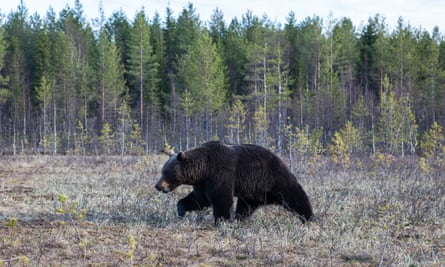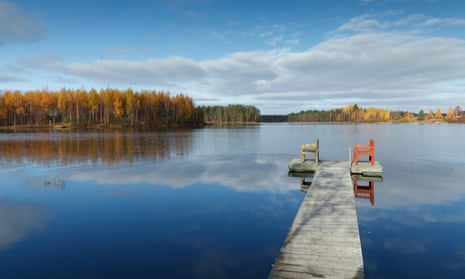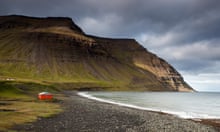In a hide two miles from the Russian border in Finland’s Suomussalmi region, we watch and wait. For centuries, the European brown bear has been pushed by deforestation into increasingly remote areas, to do what a bear proverbially does in woods. Luckily, in Finland, where 76% of the land mass is dense forest, a bear doesn’t have to go very far for a little private time.
Jani, our guide from the Martinselkonen Eräkeskus wildlife centre, has guaranteed us a sighting and, just 20 minutes in, we watch a shaggy brown beast lumber into view, lit by the pinkish-blue midnight sun. She’s shortly followed by her suitor, a huge fellow determined to win her over by marking his territory on every tree he can find. He doesn’t have much success, but we enjoy a few hours of watching bears in their natural habitat, eating, moseying around and fending off amorous Romeos.

Bear watching aside, the main reason for my visit to this part of Finland is to explore the newly inaugurated Hossa national park, a short drive away. It was opened on 17 June as part of celebrations to mark 100 years of independence from Russia, and €2.5m has been spent updating this 110 sq km area into a modern, accessible, waymarked park, with nature trails, mountain biking routes and pristine lakes and rivers.
I explore first by bike, winding along narrow forest trails and newly laid boardwalks by expanses of shimmering water. Summer has come late this year, but the ice is melting fast and I can hear it creaking on the lake’s surface, finally relinquishing its grip on the quickening water. The ice breaks easily: I hold great chunks of it, like cut-glass honeycomb, and crumble it into tinkling shards.

Hossa makes a great budget trip: there’s no entry fee, and those prepared to carry supplies can spend several days exploring, staying in traditional lean-to laavu shelters (free of charge), drinking pure lake water and cooking at the plentiful campfire sites. The Finnish concept of jokamiehenoikeus – “everyman’s right” – means it’s also legal to wild camp and forage for berries and mushrooms. But this isn’t obligatory: there are plenty of reasonably priced rental huts in the park, too. I’m staying at Hossan Lomakeskus, with accommodation in sleek wooden huts with floor-to-ceiling windows and uninterrupted views of Hossa lake.

“We want to attract a younger, more international crowd,” says Maija Daly, who helps tourism-related businesses set up in the park. “The park has been popular with old-school hikers and fishermen for years, but now we are offering upgraded accommodation and extended activities.”
One of the aspiring entrepreneurs is Saija, who offers nature and wellbeing services in what she calls the “Healing Forest”. On our small group walk, she describes how oils emitted by the pine trees are absorbed by humans’ lymphatic systems, helping reduce stress and depression. “I feel there has been a loss of connection with nature in modern life. I want to help people reconnect with its rhythm,” she says, before guiding us – clumsy in our hiking attire – through some basic yoga.

Saija leads us to a new metal walkway over Lake Somerjävi to view the 4,000-year-old Värikallio rock paintings, one of the major attractions of Hossa’s shamanistic history. The impressive red-and-ochre figures stare back over the lake, and I reflect that not much has changed in this serene spot since they were painted.
At the time of my visit, Julma Ölkky, the largest canyon lake in Finland and the jewel in Hossa’s crown, is still frozen, but canoe guide Janne is not daunted: “Hossa’s waters are unsurpassed in their accessibility. There are so many options here for all levels and abilities.” The two-man Indian canoe we take out on Hossa Lake is perfect for a beginner, and I am quickly at ease, paddling out into the still water, admiring reflections of forest and sky.

“Hossa epitomises the definitive Finnish romantic landscape,” Riita, one of the park’s special advisers, tells me, “and it’s the clarity of the water that makes it so unique.”
Because Hossa is more than 750km from Helsinki – requiring an internal flight to Kuusamo, a two-hour drive away – it’s not the simplest park to get to, but it is a worthy addition to Finland’s finest.
Back at the Martinselkonen Eräkeskus centre, after our hike, I indulge in a favourite Finnish pastime and close my eyes to relish the enveloping heat of the sauna. My mind wanders back to the bears and I silently wish Romeo as much luck in finding his mate as I’ve had finding this stunning spot.










Comments (…)
Sign in or create your Guardian account to join the discussion